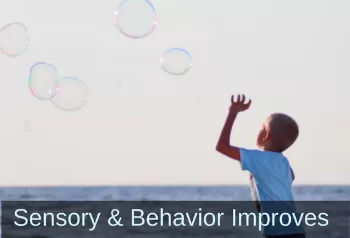Primitive Reflex Integration Case Studies
Movement Helps Sensory & Behavior for 9-Year-Old
Sensory processing, regulation, and attention improve after rhythmic movement intervention
Innate rhythmic movements made a big difference for this boy who had an under-responsive sensory system, challenges with self-regulation, and difficulty attending to academic tasks.
Submitted by C.S., Occupational Therapist

| Before | After |
|---|---|
| Poor body awareness and coordination | Improved coordination and gross motor movements |
| Under-responsivity to vestibular and proprioceptive input | Improved balance; using more appropriate force in play with peers |
| Difficulty self-regulating | Increased self-control throughout the day; better attention in therapy and academics |
Cody is a 9-year-old male receiving occupational therapy to address sensory processing concerns including decreased body awareness and coordination, under responsivity to vestibular and proprioceptive input, and self-regulation difficulties.
Following over a year of traditional occupational therapy intervention, a rhythmic movement program [from the Brain and Sensory Foundations course] was commenced within weekly sessions. After 3 weeks of implementing the rhythmic movements within therapy sessions, a home program including the 4 rhythmic movements was commenced.
Cody reported the movements made him feel calm and relaxed and even requested them independently within sessions. At the first progress note following implementation of the rhythmic movements, parent report indicated that Cody was exhibiting:
- increased self-control throughout his day
- better coordination abilities
- better attention in academic work
Parent also noted that Cody was requiring less verbal cuing to follow adult instructions.
Within 5 months, following initiation of rhythmic movement, Cody was demonstrating significant improvements in:
- attention within therapy sessions,
- regulatory abilities
- whole body coordination
- spatial awareness
- balance in gross motor movements
- improved bilateral coordination
- using more appropriate force in play with peers
Cody required very little guidance to complete the rhythmic movements in a fluid pattern at this point.
It was determined he had met his goals for therapy at this time. Cody and parent were encouraged to continue rhythmic movements at home as part of his home exercise program.
[Edited for length and clarity; emphasis added]
*Disclaimer: The activities in the Brain and Sensory Foundations curriculum make use of the natural processes of neuroplasticity and development that are innately wired in the design of human beings to promote maturity and function. These activities appear to calm, organize, and mature the neuro-sensory-motor systems just as we see in the healthy development of human infants. Individual results may vary, and we do not claim to offer a diagnosis or cure for any specific condition or disorder. The Brain and Sensory Foundations activities appear to improve overall functioning resulting in measurable improvements for a range of conditions as demonstrated in over 1800 case studies from participants.

